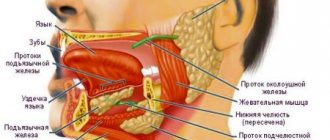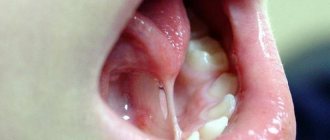What is
A lump is a formation of varying size, formed from the upper layers of the mucous membrane. The neoplasm may be white or red, as well as a bluish tint. Inside the cavity there is content consisting of lymph, blood clots, pus or pathologically altered cells.
A lump under the tongue often indicates a disease. The cause is identified based on external signs, examination of the tumor, and histological examination.
Treatment depends on the provoking factor and type of formation. Antibiotics and antiseptics are prescribed. Sometimes surgery is required.
There may be several reasons for the formation of a tumor. Most often this is damage to the mucous membrane or the development of other diseases. That is why it is important to promptly establish the cause of its occurrence, before the pathological process spreads to other tissues of the oral cavity.
Sometimes a lump in the area of the hyoid frenulum may indicate a mandibular ridge (torus).
Bone hyperplasia is in most cases benign and requires treatment only if it interferes with the installation of prostheses.
Dentist
Novikova Olga Alexandrovna
8 years of experience
Treatment is carried out after diagnostic testing and exclusion of malignancy, since a lump in the sublingual area may appear as a result of the development of oncology.
Classification
Cysts, lipomas, papillomas, and lymphangiomas usually form under the tongue. The most common types of formations that form on the oral mucosa include:
- Sialadenitis.
- Salivary gland cyst.
- Lipoma.
- Papilloma.
- Hemangioma.
- Lymphangioma.
Each type of neoplasm is characterized by certain symptoms that appear as the lump grows. They also have different causes.
Sialadenitis
Appears against the background of inflammation of the salivary glands. The causes are usually viruses, infections and pathogenic microorganisms. They penetrate into the oral cavity not only with food, but also from inside the body.
In medicine, the disease is called salivary stone disease, in which a white lump forms. A stone formed in the cavity of the formation clogs the duct and causes stagnation.
Symptoms of the disease include:
- Painful sensations in the area of the salivary glands.
- Decreased salivation and constant dry mouth.
- Difficulty swallowing.
- Enlarged gland.
You may also feel pressure and tension in the area of the duct. Treatment for salivary stone disease occurs surgically.
Cyst
A cyst under the tongue is rare. The disease is characterized by the formation of a tumor in the maxillofacial area. The cavity of the neoplasm is filled with secretion. There are several types of cysts:
- Dermoid. This is a small cone of white or gray color. At the initial stage, there are no symptoms other than mild discomfort. Over time, difficulty swallowing and chewing food appears. This type is a congenital disease and is removed surgically.
- Mucous. The cone does not reach 1 cm in diameter and has a bluish tint. It disappears upon spontaneous rupture.
- Ranula. It looks like a mucous cyst and is considered a type of cyst. It has the ability to grow up to five centimeters. After the break it appears again. The tumor can be completely removed surgically.
A ranula is a white lump with liquid inside. The reason for its appearance is the inability of the secretion to pass through the duct due to its blockage or inflammatory process.
Treatment is prescribed depending on the type of cyst. Some of them may go away on their own, while others require surgical removal. Only a doctor can diagnose the type of tumor.
Lipoma
It is formed from adipose tissue located under the mucous membrane of the oral cavity. The tumor has a benign course. Rarely diagnosed. The cone itself is always located towards the capsule and is separated by bridges.
Why can our articles be trusted?
We make health information clear, accessible and relevant.
- All articles are checked by practicing doctors.
- We take scientific literature and the latest research as a basis.
- We publish detailed articles that answer all questions.
Removal of the tumor is carried out in cases where it has reached a large size and becomes a cause of discomfort.
Papilloma
Formed from the epithelium of the mucous membrane. The cone is round or oval in shape and has a pale pink color. Papilloma can be single or multiple. In some cases it develops into a malignant formation. In medical practice, cases of spontaneous resorption are known.
Hemangioma
The lump begins to form from blood vessels as a result of embryogenesis pathology. Tissue changes are already noticeable in newborns. Has two types:
- Capillary. In appearance it resembles a small pink spot. It differs in shape, size and shade. Does not rise above the surface of the mucous membrane.
- Cavernous. When pressed, it decreases, but once again takes its previous shape. The tumor is convex and has a blue or purple tint.
Hemangioma is a congenital disease characterized by benignity and rapid growth. It may be located under the mucosa or have a part formed on the surface of the membrane.
Lymphangioma
Looks like a wart with blisters. Characterized by frequent inflammation after mechanical damage during eating. Appears more often in children of the first year of life.
In adults, according to experts, lymphangioma is formed against the background of bad habits or inflammation in harmful conditions. May have a malignant course.
When diagnosing, it is important to establish what type of neoplasm the formed lump belongs to. In certain cases, special research methods are required to establish the nature of the flow. Only after an accurate diagnosis is made, treatment is prescribed.
Types of processes
Most often, flat or pointed warts form in the oral cavity:
- Flat formations have a small protrusion above the mucous membrane and tissues, their shape is predominantly round. Condyloma differs in color from the general background in a brighter shade, so identifying it is quite simple. It is quite dense to the touch and is localized on the lower part of the tongue and oral mucosa.
Flat build-up
- Pointed papillomas form individually in the form of nodules or as a whole family, which makes them similar to cauliflower. They are moderately soft and elastic to the touch.
Pointed growth
Another type of growth is condylomas lata, which are localized not only on the tongue, but also on other parts of the oral mucosa. The reason for their appearance is syphilis.
Causes of a lump under the tongue
A tumor can occur for various reasons. Usually this is mechanical damage to the mucous membrane and inflammation during chewing of hard foods. In this case, the lump will disappear on its own after some time.
Other reasons for the formation of tumors under the tongue include:
- Wearing low-quality dentures. Sharp edges can injure the surface of the mucous membrane.
- Infections. They get into microcracks formed as a result of injury and become the cause of inflammation. If left untreated, the process affects the deep layers of the mucosa, and a tumor begins to form.
- Salivary stone disease. The lump occurs in the area where the stone is formed.
- Genetic predisposition.
- The first stage of syphilis. A ball forms under the tongue, which causes pain when pressed or during conversation. After a while he disappears.
A tumor under the tongue can form against the background of the development of oncological pathologies. That is why it is important to promptly contact a specialist who will determine the cause and nature of the disease.
Possible consequences
Since the bladder negatively affects the functioning of the salivary glands, digestion may be primarily affected. Food without a normal amount of saliva is poorly digested, and the body ceases to receive sufficient amounts of vitamins and minerals. All this negatively affects the immune system, which leads to a number of diseases.
A scar may also form, which will interfere with the normal functioning of the salivary glands. As a complication, a purulent, inflammatory process called sialadenitis can occur.
Diagnostics
In the early stages, the disease is difficult to detect, since the lump is small and does not show symptoms. A preliminary diagnosis is established based on the patient's complaints and visible signs. The doctor carefully examines the tumor to determine its characteristics.
For confirmation, a histological examination is prescribed. To do this, cells from the tissue of the cone are collected with a special instrument, and then the sample is sent to the laboratory.
In some cases, consultation with other specialists, such as an oncologist, may be necessary.
Treatment
The treatment regimen depends on the type of tumor and the reasons why it appeared. Lumps in the sublingual area resulting from mechanical trauma are strictly prohibited from piercing.
Self-medication is dangerous with complications!
Attention
Despite the fact that our articles are based on trusted sources and have been tested by practicing doctors, the same symptoms can be signs of different diseases, and the disease may not proceed according to the textbook.
Pros of seeing a doctor:
- Only a specialist will prescribe suitable medications.
- Recovery will be easier and faster.
- The doctor will monitor the course of the disease and help avoid complications.
find a doctor
Do not try to treat yourself - consult a specialist.
Once the contents are released, the wound may become infected. It is also not recommended to consume sour, spicy, hot foods, or alcoholic drinks, as they irritate the mucous membranes and provoke inflammation.
All oral diseases are associated with poor hygiene or lack thereof. Over time, plaque accumulates on the teeth and gums, creating a favorable environment for bacteria and microorganisms. As they multiply, they cause inflammation and many pathologies. To eliminate the problem, rinses with special antiseptic solutions are prescribed.
In cases of diagnosing sialolithiasis, antibiotics and mouth rinsing are indicated. It is also recommended to eat foods that promote saliva production. With sialadenitis, the neoplasm may not go away for a long time, even after the cause is eliminated.
In case of cyst formation, surgical intervention and disinfection of the oral cavity with antibiotics are indicated. Lipoma does not pose a threat to human health. During its formation, observation by a dentist is indicated.
For a malignant tumor, radiation therapy, chemotherapy or surgical removal is prescribed, depending on the extent and form of the disease.
How to treat a blood bladder?
General therapy
Depending on the type of pathological condition that caused the appearance of a blood bubble in the mouth, treatment can be carried out with the following medications:
- In case of traumatic formations that go away on their own over time, the oral cavity is treated with antiseptic agents
For candidal stomatitis, antifungal drugs such as Levorin and Nystanin are effective.
- For diseases of viral etiology, the treatment regimen includes Viferon, Amoxicillin, Tsiprolet, Azithromycin.
- To combat gingivostomatitis, where it is expected to remove areas affected by necrosis, antiallergic medications, antibacterial agents, and vitamin complexes are used.
- In case of traumatic formations that go away on their own over time, the oral cavity is treated with antiseptic agents. If there is pain, the doctor may prescribe Cholisal, Ketoprofen, Voltaren, Lornoxicam, Kamistad.
- To eliminate tuberculosis, appropriate chemotherapy is prescribed, which includes Rifampicin, Ioniazid, Pyrazinamide.
Local therapy
To speed up the healing process, regularly rinse with antiseptic agents. Furacilin, Chlorhexidine, Stomatidine, Betadine, Miramistin, hydrogen peroxide solution, Iodoform, Chlorophyllipt show good results.
Treatment of the affected tongue with disinfectant solutions should be performed twice a day, at a minimum, but before that you must brush your teeth and remove any remaining food.
It is advisable to eat food after the procedures within 30-60 minutes, which will significantly increase their effectiveness.
Traditional methods
Aloe or Kalanchoe juice has a wound healing effect
To alleviate the condition, it is good to use healing decoctions based on chamomile, sage, yarrow, St. John's wort, and viburnum fruits.
They are prepared at the rate of 1 tbsp. herbal raw materials per 1 glass of water.
The mixture is brought to a boil and left for 2-3 hours to infuse. Before use you need to strain.
Aloe or Kalanchoe juice has a wound-healing effect.
Oil from sea buckthorn and rosehip also has the same property. They are applied directly to the affected area.
These agents accelerate the regeneration process, prevent the proliferation of pathogenic microorganisms and anesthetize the lesion.
A solution prepared from salt (1 tsp), 3 drops of iodine and soda (1 tsp) is a universal remedy in the fight against inflammatory processes in the oral cavity.
These components are mixed in one glass of warm boiled water and used for lotions and rinses. It is also good to treat the affected areas with hydrogen peroxide.
Prevention
In order to prevent the development of any oral disease, you should follow the rules of hygiene. It is also important to choose the right toothbrush, since bristles that are too hard can injure the mucous membrane.
If an infectious disease develops, you should undergo the entire course of treatment, since the inflammatory process can spread throughout the body, reducing immunity and causing the formation of a lump.
A tumor under the tongue may indicate the development of serious diseases, such as oncology, or appear as a result of improper oral hygiene. When the first symptoms occur, you should contact your dentist, who will determine the cause and extent of the disease.
Which people are susceptible to papillomas?
Based on the information we provided above, we can distinguish several “risk groups”, people in which are susceptible to the development of growths and neoplasms on the tongue and body.
The appearance of a process on the tongue is possible:
- In a situation where a person has reduced immunity as a result of stress, the presence of parasites in the body or ongoing inflammatory processes.
- If a patient with a growth in the mouth suffers from autoimmune diseases.
- In a person with HIV infection.
- In people who are promiscuous.
- In the event that a person has bad habits. Smoking and drinking alcohol especially contribute to the appearance of neoplasms in the form of growths on the tongue.
- If there was any trauma to the tongue or damage to the mucous membrane occurs systematically.









